Womanhouse Now: Films and Experimental Shorts
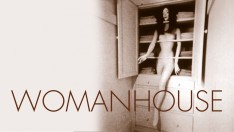
Womanhouse
Los Angeles Filmforum, Anat Ebgi, and Los Angeles Nomadic Division present
Womanhouse Now: Films and Experimental Shorts
Online Tuesday June 28 - Sunday July 10, 2022
Including a pre-recorded conversation with Judith Dancoff, Cheri Gaulke, Karen LeCocq , Johanna Demetrakas, and Anat Ebgi Senior Director Stefano Di Paola
Tickets: $12 general, $8 recommended for students/seniors (sliding scale), $0 Filmforum members.
Tickets and screening here.
In celebration of the fiftieth anniversary of Womanhouse a site specific installation and performance-space, Anat Ebgi Gallery in partnership with LAND (Los Angeles Nomadic Division) and LA Filmforum have organized an afternoon of films including Johanna Demetrakas 1974 documentary on the Womanhouse home alongside a set of experimental shorts from participating artists like Shawnee Wollenman, Judith Dancoff, Judy Chicago, and Cheri Gaulke.
Guests:
After working in documentary film for a number of years, Judith Dancoff left filmmaking for her true calling as a writer. Her award-winning short stories, essays, and a novella have appeared in numerous publications including The Georgia Review, Alaska Quarterly Review, Southern Humanities Review, and others. Her awards include a Pushcart Prize nomination, and residencies at Hedgebrook, VCCA, and Djerassi, where she was the McElwee Family Fellow. Her work continues to be inspired by ideas of feminism as well as an exploration of the artistic practice. A secondary interest stems from her father's work as a Manhattan Project physicist. She is currently at work on a hybrid memoir/novel about her father. For more information about Judith's writing, visit http://judithdancoff.com/.
Visionary filmmaker Johanna Demetrakas’ first documentary, Womanhouse, about a ground-breaking feminist art installation, won a spot in the Whitney Museum's New American Filmmaker Series, played at the Venice Biennale and was later acquired by the Pompidou Centre in Paris. Her second effort, Right Out of History: The Making of Judy Chicago's Dinner Party, was met with international acclaim at the London and Berlin Film Festivals. Her recent film Crazy Wisdom was nominated for a Jury award at the Santa Barbara Film Festival. Demetrakas is also an Emmy nominated editor of over two dozen films including: Busrider's Union which she co-directed with legendary cinematographer Haskell Wexler and the Emmy winning Amandla! A Revolution in Four Part Harmony, winner of both the Audience and Freedom of Expression Awards at Sundance. She is on the faculty of USC’s School of Cinematic Arts.
Cheri Gaulke’s long career has included solo performance art, as well as the creation of collaborative groups Feminist Art Workers 1976) and Sisters Of Survival (1981). She has created 10 public artworks in Southern California. She has made 27 films since the 1970s and is currently directing her first feature documentary, Acting Like Women, about feminist performance art in 1970s-80s Los Angeles.
Karen LeCocq is a mixed media sculptor who has shown internationally in galleries and museums, among them: The Whitney Museum of American Art, NY, New York, The Armand Hammer Museum, Los Angeles, CA and the Museum of Contemporary Art, Los Angeles, CA. Her work gained international recognition through its use in the Absolut Vodka Signature Artist campaign. LeCocq was part of the first feminist art program taught by Judy Chicago in 1970 at California State University Fresno. Her education continued with her participation in the second feminist art program from 1971-73 at California Institute of The Arts under Chicago and Miriam Shapiro where she was part of the internationally acclaimed project, Womanhouse in 1972. LeCocq has been the recipient of numerous awards including Sculptor of the Year from Absolut Vodka and the Honor Roll of Feminist Artists from the Veteran Feminists of America for her major contribution to the second wave feminist revolution, 1966-1980.
Stefano Di Paola is Partner and Senior Director at Anat Ebgi, Los Angeles. Stefano joined Anat Ebgi in 2014 and has helped to grow the gallery's program, helping to bring on artists such as Faith Wilding, Jordan Nassar, Janet Werner, and Tammi Campbell. He is additionally a partner in the project space, Sow & Tailor, alongside artist Greg Ito and his wife Karen Galloway. Previous to joining Anat Ebgi, Stefano worked at the ONE Archives in Los Angeles and the Peggy Guggenheim Collection in Venice, Italy.
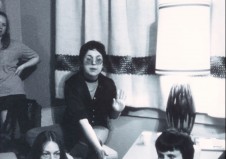
Judy Chicago & the California Girls, by Judith Dancoff
Judy Chicago & the California Girls
By Judith Dancoff
1974, 25 minutes, 16mm, screening digitally
At the height of the 1970's Women's Movement, on the cusp of revolutionary change, American artist Judy Chicago began a unique experiment: to train only young women artists in an all-woman art program at Fresno State College. So many young women were going into art schools, Chicago states, so few coming out the other end as professional artists. The film "Judy Chicago & the California Girls" documents this first all-woman art program, in a compelling and candid portrait of a country and culture in the midst of great social change. Highlights include a visit by radical feminist theorist Ti-Grace Atkinson, Chicago's early performance pieces the "Cock Cunt Play" and the "Cunt Cheer", and Chicago's female-centered philosophy that shaped her later work. Some of Chicago's students who appear in the film and went on to become important artists in their own right include Faith Wilding, Suzanne Lacy, Nancy Youdelman and Vanalyne Green. https://judychicagoandthecaliforniagirls.com/
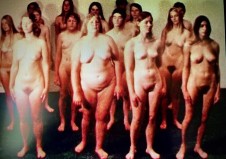
Blades of Grass (Women in The Wind), by Karen LeCocq
Blades of Grass (Women in The Wind),
By Karen LeCocq
1971, 2:51 min., color, silent, filmed on super 8mm, screening digitally
I gathered together 15 women who were willing to be filmed naked. I instructed them to close their eyes and gently rock back and forth and side to side in circles. I told them to imagine themselves as blades of grass gently blowing in the wind. Jan Lester was the camera person. There was a variety of body shapes and colors giving a very organic and natural appearance to the scene.
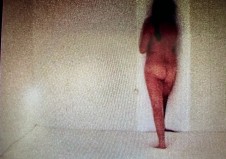
White Environment (White Cunt), by Karen LeCocq
White Environment (White Cunt)
By Karen LeCocq
1970, 3:15 min. color, silent, filmed on super 8mm, screening digitally
I constructed a room 17’ x 8’ from 2x4s and sheet rock. The walks were painted white. The ceiling was a large stretched canvas over a 2” x 2” pine frame. Hanging from the curling were 129 pieces of clear nylon thread with 2” plastic discs attached at the end. I covered the floor with 4” polyurethane foam. The entrance measured 6’h x 3’w and was 4” thick polyurethane foam slit down the center. The viewer had to slip through the center to enter. In the 4 corners of the room I installed 4 crimson 15 watt lightbulbs that cast a warm rich glow. A small fan was installed to move the ceiling discs. The moving discs created a liquid motion. The concept behind the soft spongy floor, the liquid motion on the ceiling, the push in, expanding contracting entrance all dealt with my experience as a woman. I was allowing the viewer to enter inside me and enjoy my softness, my liquidness and my way of feeling.
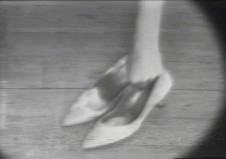
Eclipse in the Western Palace, by Cheri Gaulke
Eclipse in the Western Palace
By Cheri Gaulke
1977, 5 minutes, b&w, sound
Cheri Gaulke filmed this piece with a Sony PortaPak camera in her studio in Pasadena in 1977. At the time Gaulke was a student in the Feminist Studio Workshop at the Woman’s Builidng and was subletting studio space from Barbara T. Smith. In the video a female body part appears to devour an army of high heels until she causes the eclipse of this Western form of torture with a warrior yell and by slamming her legs together. This is an early artwork that shows Gaulke’s interest in women’s feet and shoes as metaphors for mobility in society and as an opportunity to critique gender codes in fashion. Over the years Gaulke has created numerous works in video, sculpture, and performance art, including her Pacific Standard Time interactive installation at LACE called Peep Totter Fly (2011-12).
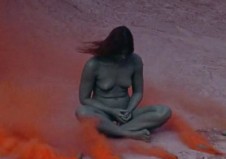
Woman and Smoke, by Judy Chicago
Woman and Smoke
By Judy Chicago
1971-72, 15:13, screening digitally, color, silent
Between 1968 and 1974 Chicago executed a series of increasingly complex fireworks pieces that involved site specific collaborative performances around California. Some of these works were intended to transform and soften the landscape, introducing a feminine impulse to the environment, while others focused on re-creating early women-centered activities like the kindling of fire or the worship of goddess figures. Chicago explains that “the smoke provided a liberation from formal structure, while color was intended to feminist and soften the environment.” These ephemeral smoke pieces were a response to what Chicago considered the male-dominated 60s art scene, and then-growing emphasis on monumental outdoor Land Art male artists.
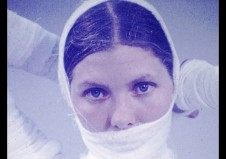
Dressing, by Shawnee Wollenman
Dressing
By Shawnee Wollenman
1972, 12:47, digital, color, sound
This film—originally shot on 16mm—was made by Shawnee Wollenman in 1972 while she was a student at CalArts. Artist and fellow CalArts student, Catie Marzio sits on a stool directly facing the camera as she proceeds to wrap her entire body in white medical gauze. The wrapping covers every part of her, every limb, extremity, and her entire face, in a gesture both silencing and suffocating, while perhaps suggestive of a cocoon. The film features a “soundtrack” of heavy, slow breathing. Wollenman’s work is concerned with violence and challenges women face around the world. Interestingly, after completing her BFA in fine art at CalArts, Wollenman pursued graduate degrees in nursing and psychology and worked for many years as a Registered Nurse in addition to continuing her art practice. Wollenman was one of the founding artists who participated in the Fresno State Feminist Art Program.
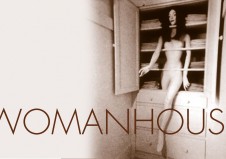
Womanhouse, by Johanna Demetrakas
Womanhouse
By Johanna Demetrakas
1974, 47 minutes, color, sound, 16mm screening digitally
WOMANHOUSE is an historic documentary about one of the most important feminist cultural events of the 1970s. Judy Chicago (best-known as the creator of THE DINNER PARTY) and Miriam Shapiro rented an old Hollywood mansion and altered its interior through decor and set-pieces to "search out and reveal the female experience...the dreams and fantasies of women as they sewed, cooked, washed and ironed away their lives." WOMANHOUSE is a fascinating historical look at feminism, its reception in the 1970s, and the ever-important relationship between art and social change.
